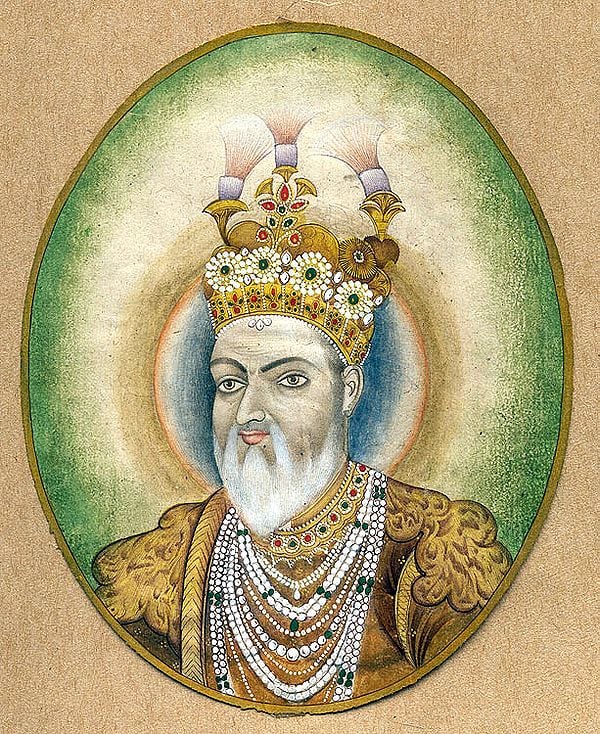image source: https://www.exoticindiaart.com
Welcome to the fascinating world of Bahadur Shah Zafar, the last Mughal emperor of India. Despite being known as a ruler, he was also a renowned poet and a patron of arts and literature. His reign marked the end of the mighty Mughal dynasty and the beginning of British dominance in India. Join us as we delve into the life and legacy of Bahadur Shah Zafar, a figure that continues to capture the imagination of many.
Uncovering the Untold Story of Bahadur Shah Zafar: The Last Mughal Emperor
Bahadur Shah Zafar is a name that is often overshadowed by the more prominent Mughal emperors such as Akbar and Aurangzeb. However, his rule marked a critical period in the Mughal Empire and his story is one that is often forgotten or overlooked. In this article, we will delve into the life of Bahadur Shah Zafar and uncover the untold story of the last Mughal emperor.
Bahadur Shah Zafar was born on October 24, 1775, in Delhi, India. He was the second son of Akbar Shah II and became the successor to the Mughal throne after the death of his father in 1837. He was not the first choice as heir, as his older brother, Mirza Jahangir, was favored by their father. However, Mirza Jahangir died in 1830, leaving Bahadur Shah Zafar as the next in line.
Bahadur Shah Zafar’s reign began during a tumultuous time for the Mughal Empire. The British had already established their dominance in India and the Mughal Empire was reduced to a mere figurehead. Bahadur Shah Zafar’s rule was marked by political instability and constant rebellion against British rule.
Despite the limited power he held, Bahadur Shah Zafar was a poet and patron of the arts. He was a skilled calligrapher and his court saw a flourishing of Urdu poetry and literature. He was known for his liberal and tolerant views, which earned him the admiration and support of Hindus and Muslims alike.
However, his liberal views also made him a target for the conservative Muslims and the British. In 1857, a rebellion known as the Indian Rebellion or Sepoy Mutiny broke out, which aimed to overthrow British rule in India. Bahadur Shah Zafar was declared the leader of the rebellion, although he was hesitant to take on such a role. He was eventually captured by the British and exiled to Burma, where he died in 1862 at the age of 87.
The rebellion was ultimately unsuccessful and marked the end of the Mughal Empire. Bahadur Shah Zafar’s sons were executed by the British, and his descendants were forced into poverty and obscurity. It was not until the Indian independence movement in the early 20th century that Bahadur Shah Zafar’s legacy was revived.
Today, Bahadur Shah Zafar is remembered as a symbol of resistance against British colonialism and a promoter of Indian culture and literature. He is also known for his famous last words, “Kitne aadmi thay?” (How many were there?), which were spoken when he was captured by the British.
In conclusion, Bahadur Shah Zafar’s story is one of a man caught in the crossfire of a changing world. He ruled during a time of great turmoil and his legacy has been overshadowed by the more prominent Mughal emperors. However, his contributions to literature, art, and culture cannot be ignored, and his role in the Indian Rebellion serves as a reminder of his bravery and resilience. Bahadur Shah Zafar may have been the last Mughal emperor, but his legacy lives on, inspiring generations to come.In conclusion, Bahadur Shah Zafar was the last Mughal emperor of India and his reign marked the end of an era in Indian history. Despite facing many challenges and ultimately being deposed by the British, his legacy lives on as a symbol of resistance and resilience. His contributions to literature and poetry continue to be celebrated and remembered, making him an important figure in Indian culture. The life and reign of Bahadur Shah Zafar will forever be a significant part of India’s rich and diverse history.
Reference
- Dharmendra Lip-Syncs To Ghazal Originally Penned By Mughal Emperor Bahadur Shah Zafar, https://menafn.com/1107992125/Dharmendra-Lip-Syncs-To-Ghazal-Originally-Penned-By-Mughal-Emperor-Bahadur-Shah-Zafar
- From Akbar to Shah Jahan: Mughal India’s syncretic spirit, https://gulfnews.com/opinion/from-akbar-to-shah-jahan-mughal-indias-syncretic-spirit-1.101952481
- Dharmendra lip syncs to ghazal penned by Bahadur Shah Zafar, https://www.orissapost.com/dharmendra-lip-syncs-to-ghazal-penned-by-bahadur-shah-zafar/
- Dharmendra Lip Syncs To Ghazal Penned By Bahadur Shah Zafar, https://www.outlookindia.com/art-entertainment/dharmendra-lip-syncs-to-ghazal-penned-by-bahadur-shah-zafar
- Dharmendra lip syncs to ghazal penned by Bahadur Shah Zafar, https://www.punjabnewsexpress.com/entertainment/news/dharmendra-lip-syncs-to-ghazal-penned-by-bahadur-shah-zafar-244115
- More ICICI BANK Branches in NEW DELHI, DELHI, https://economictimes.indiatimes.com/wealth/ifsccode/bank-icici-bank,state-delhi,district-new-delhi,branch-new-delhi-bahadur-shah-zafar-marg,ifsccode-ICIC0000386.cms
- MCB Bank Bahadur Shah Zafar, Link Road, Sargodha Branch Bank, https://hamariweb.com/directories/default.aspx?aspxerrorpath=/directories/imp.aspx
